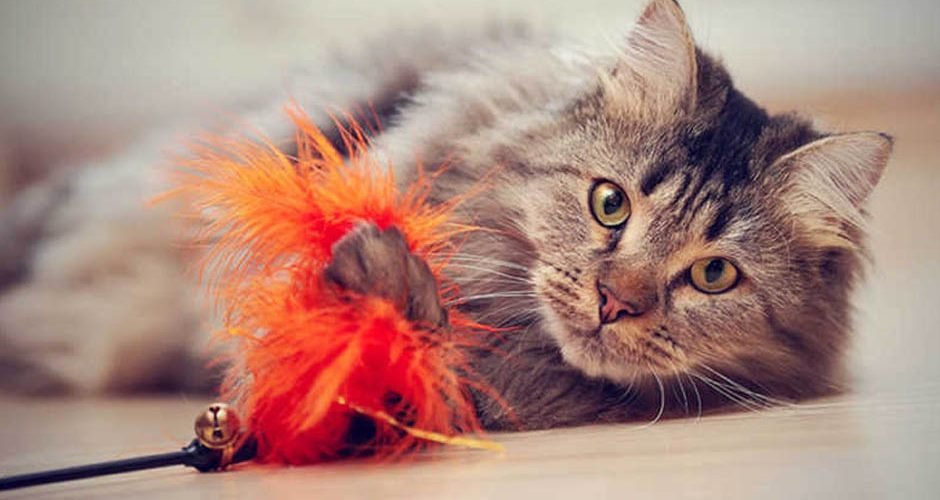Cats, with their playful antics and curious nature, have a special place in our hearts. Ensuring their well-being also involves keeping them entertained and mentally stimulated. Choosing the right toys for them, however, can be a tad challenging.
In this article, we’ll walk you through some of the absolute essentials of finding the right toy for your cat friends. We’ll first begin with some of the important tips and strategies for you to keep in mind, then will explore the different varieties of toys that you could possibly look at. We’ll also look at what you can do to properly maintain your pets toys and replace them when needed.
Let’s begin!
Table of Contents
Tips and Strategies for Picking the Best Toy for Your Feline Friends
Embarking on a quest to find the ideal toys for your feline friend can be an enthralling experience. Cats, with their capricious nature, can sometimes make it a perplexing endeavor to identify what will genuinely captivate their interest. To simplify this journey, we present a comprehensive guide filled with tips and strategies to assist you in cherry-picking the best toys that will not only keep your kitty amused but also ensure their safety and well-being.
1. Understand Your Cat’s Personality
- Observer vs. Participant: Identify whether your cat enjoys observing their surroundings passively or actively engages in play.
- Individual Play vs. Interactive Play: Ascertain whether your cat enjoys solitary play or prefers interaction either with you or other pets.
Understanding your pet grooming client (the furry friends) is always a good starting point for picking the best toy for them!
2. Age-Appropriate Toys
- Kittens: Choose soft, chewable toys and ones that facilitate developmental play.
- Adult Cats: Provide a mix of interactive and independent toys.
- Senior Cats: Focus on gentle, easy-to-navigate toys that don’t exert undue pressure on their joints.
3. Safety is Paramount
- Choking Hazards: Ensure toys do not contain small parts that can be detached and swallowed.
- Non-toxic Materials: Ensure that the toys are made of materials safe for chewing and handling.
- Size Appropriateness: Choose toys that are of a suitable size to prevent accidental swallowing or choking.
4. Introduce a Variety
- Types of Toys: Offer a range from interactive toys, chew toys, cuddle toys, to stimulatory toys to keep their interest piqued.
- Rotating Toys: Keep a few toys out at a time and rotate them regularly to sustain their novelty.
5. Opt for Multisensory Appeal
- Visual Stimuli: Select toys that are visually enticing, like fluttering butterflies or moving toys.
- Auditory Engagement: Toys that generate sounds, like crinkles or squeaks, to captivate their auditory senses.
- Tactile Experience: Varied textures like soft plush, rough sisal, or smooth rubber to offer diverse tactile experiences.
6. Simulate Natural Behaviors
- Hunting Simulations: Toys that mimic prey, like small, fast-moving objects or fluttering toys.
- Scratching Needs: Incorporate toys that also allow them to exercise their natural scratching instincts.
- Climbing and Exploring: Invest in toys that promote exploration, like tunnels or climbing structures.
7. Include Reward-Based Toys
- Treat-Dispensing Toys: To mentally stimulate them and reward their problem-solving skills.
- Interactive Puzzle Toys: Engage them mentally and often allow for treats to be hidden as rewards.
8. Be Mindful of Individual Preferences
- Favorites: Identify and prioritize toys that your cat naturally gravitates towards.
- Dislikes: Note and avoid types or categories of toys your cat consistently ignores.
9. Easy Maintenance
- Washable: Opt for toys that are easy to clean and maintain.
- Durable: Invest in toys that can withstand the vigor of playful paws and sharp claws.
10. Observe and Adapt
- Monitor Play: Understand what excites or deters your cat during play and adapt the toy selection accordingly.
- Be Flexible: If a certain toy doesn’t resonate with your cat, be willing to switch it out for something else.
11. Engage in Interactive Play
- Bonding Time: Use toys like danglers or wands to actively participate in your cat’s playtime.
- Monitoring: Engaging in play allows you to observe any changes in play behavior, which might indicate health issues.
Varied Toys for a Content Cat
Embarking on a journey to find toys that will captivate your feline friend’s attention is both thrilling and essential. Diverse types of toys can safeguard against boredom and promote physical activity, mental stimulation, and overall happiness. Let’s delve deeper into the diverse world of cat toys, ensuring each kind represents a distinct type of play and addresses varied needs.
1. Interactive Toys
a. Puzzle Toys
- Utility: Engage mental faculties and are usually employed to dispense treats or food, making your cat work for its reward.
- Examples: Ball dispensers, puzzle boards.
- Benefits: Enhances problem-solving skills and slows down eating pace.
b. Automated Laser Toys
- Utility: Engage your cat in a chase, enhancing their physical activity.
- Note: Ensure to provide actual catchable toys alongside to prevent frustration due to the intangible nature of the laser.
2. Chew Toys
a. Dental Chew Toys
- Utility: Designed to promote dental health by reducing plaque and massaging gums.
- Material: Often made of rubber or mesh material.
- Note: Always supervise play to avoid accidental ingestion.
b. Stuffed Chew Toys
- Utility: Provide an outlet for biting and chewing instincts.
- Examples: Soft toys filled with catnip or crinkly material that provokes interest through sound and scent.
3. Wand Toys
a. Feather Wands
- Utility: Mimic birds, invoking natural hunting instincts.
- Benefits: Facilitates bonding when you engage in play with your cat.
b. Wand Toys with Bells or Crinkles
- Utility: Produce noise that attracts and retains feline attention.
- Note: Check for secure attachment of bells to prevent choking hazards.
4. Balls and Autonomous Toys
a. Balls with Bells
- Utility: Provide an avenue for solo play, the bells incite curiosity and engagement.
- Benefits: Facilitate independent play even in your absence.
b. Robotic Toys
- Utility: Move unpredictably, offering a realistic prey simulation.
- Benefits: Keeps your cat entertained and engaged in physical activity.
5. Comfort Toys
a. Plush Toys
- Utility: Serve as cuddle partners during nap times and can be a target for playful bunny kicks during active moments.
- Examples: Soft stuffed animals, pillow-like toys.
b. Scented Toys
- Utility: Infused with catnip or silver vine to elevate your cat’s interest and interaction with the toy.
- Benefits: Provide both active play and comfort during downtimes.
6. Climbing and Scratching Toys
a. Cat Trees and Condos
- Utility: Offer vertical space, hiding spots, and scratching surfaces.
- Benefits: Facilitate exercise, secure territory, and satisfy scratching instincts.
b. Wall Shelves and Bridges
- Utility: Provide elevated pathways and perches.
- Benefits: Enable exploration and territory expansion.
7. Teasers and Danglers
- Utility: Engage your cat in a playful “attack” and “catch” style of play.
- Benefits: Stimulate hunting instincts and facilitate interactive play.
Note on Varied Play
Remember that variety is key in preventing boredom and encouraging a range of physical activities. Your cat might exhibit preferences, and while it’s essential to cater to those, introducing new toys from different categories occasionally can keep their environment stimulating and enriched.
By presenting a varied toy selection, you not only contribute to fulfilling days for your cat but also ensure they have outlets for their inherent behaviors and instincts, thereby promoting a mentally and physically healthy life. This diversified approach in providing play opportunities mirrors the comprehensive care strategy that encompasses varied aspects like regular vet visits, a balanced diet, and grooming facilitated by platforms utilizing sophisticated pet grooming software to manage appointments and client interactions efficiently.
Maintaining and Replacing Toys
Exploring the intricacies of maintaining and replacing toys for our feline friends reveals a spectrum that extends beyond mere playful interactions. Keeping a keen eye on the conditions of these playthings safeguards the physical well-being of our cats, while also nurturing their emotional and psychological health through consistent and stimulating play experiences.
1. Regular Inspection
Embarking on the journey of regular inspection starts with a commitment to daily checkups of your cat’s toys. This ensures that any visible wear and tear, loose parts, or potential hazards are promptly identified, maintaining a safe play environment.
The act of squeezing, stretching, and observing toys meticulously becomes instrumental in discerning any irregularities or damages that could pose potential risks to your pet. Furthermore, post-play observations cater to identifying any transformations in the toy’s condition, particularly after vigorous play sessions. Examining toys for damages such as splits, tears, or any loose components not only ensures the longevity of the toys but also preserves the safety and integrity of your pet’s playtime.
2. Cleaning and Sanitizing Toys
Understanding the cleaning guidelines for your pet toys spirals into ensuring their longevity and protecting them from becoming a breeding ground for bacteria. By adhering to the cleaning instructions, which are often provided by the manufacturer, you pledge to maintain a sanitary and safe play environment.
Moreover, scheduling regular cleans plays a pivotal role in sustaining a hygienic play environment and mitigating the risk of infections or allergies. Designating a day for toy cleaning, whether weekly or bi-weekly, depending on the toy’s material and usage, ensures that the toys remain in optimal condition and safe for continuous enjoyment.
3. Repairing Toys
Diving into the realm of repairing toys, we find that minor repairs can significantly prolong the life of a toy, ensuring that the investment in your cat’s entertainment and stimulation remains fruitful. Stitching up minor tears or reattaching loose parts, while ensuring they are secure and safe, can result in an extended life for the toy and continued enjoyment for your cat.
Additionally, recognizing irreparable toys is crucial in safeguarding against potential dangers. Acknowledging when a toy is beyond repair and continuously poses risks despite attempts to fix it signifies that it’s time to retire the toy, prioritizing your cat’s safety.
4. Recognizing When to Replace Toys
Observing your cat’s interest becomes a vital facet of understanding when to replace toys. Ensuring that toys still harbor an appeal and engage your pet means continually evaluating your cat’s response to each toy. If a toy no longer elicits excitement or interaction, it heralds the time to introduce something new and stimulating.
Moreover, being vigilant to spot wear and tear ensures that potential hazards are mitigated. If a toy reveals significant signs of deterioration, such as deep cracks or missing pieces, it becomes imperative to replace it, thereby averting potential dangers associated with damaged toys.
5. Organizing and Storing Toys
Organizing and storing toys appropriately involves dedicating specific storage that ensures the play area remains tidy and the toys retain their condition. Utilizing a dedicated box or basket to store toys when not in use shields them from unnecessary dirt or damage, prolonging their utility and appeal.
Additionally, rotating toys between active use and storage guarantees that each toy maintains its novelty and allure, keeping the play experience fresh and engaging by providing varied stimulations in a cyclic manner.
6. Disposing of Old Toys Safely
The act of disposing of old toys is a strategy steeped in ensuring that worn-out toys are eliminated in a manner that eradicates any risk of your cat retrieving and engaging with them.
This not only safeguards against the potential dangers of playing with a damaged toy but also redirects your cat’s focus towards the newer, safe, and stimulating options available within their play environment.
Toys and Overall Pet Care
Choosing the right toys is one of the many facets of comprehensive pet care, which also encompasses nutrition, health, and grooming. Implementing a diligent grooming routine, either at home or through professional services that might utilize advanced pet grooming software for optimal service delivery, also impacts your pet’s overall wellbeing.
Conclusion
Identifying the ideal toys for your cat incorporates understanding their personality, ensuring safety, providing a diverse range, and maintaining those toys properly. While toys significantly contribute to a cat’s happiness and health, adopting a holistic approach ensures they lead a fulfilled, joyous life.
Offering a stimulating environment for your cat that prioritizes safety and satisfaction will not only keep them healthy but also strengthen the bond you share with your furry friend. So, dive into the enchanting world of cat toys and find the ones that make your kitty’s paws dance with joy!
Author Bios: Ashley drives content strategy at Punchey, a cutting edge cloud-based software for small business owners. She loves interacting with hustlers and researches growth and marketing solutions.





